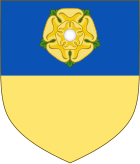Riario
The Riario are an Italian noble family from Savona in Liguria, which owes their rise - especially in the Roman Catholic hierarchy and in the papal nobility - to the relationship to the Renaissance - Pope Sixtus IV (Francesco della Rovere) and his nepotism . They are still part of the European nobility today .
history
According to legend, the Riario descend from a Degenardo who was a captain under Emperor Friedrich Barbarossa . There is evidence that the line of tribe begins with Paolo Riario († 1453/59), a wealthy craftsman from Savona. Around 1440 he married Bianca della Rovere , sister of the then Franciscan and theology lecturer Francesco della Rovere from the same town, who was elected Pope as Sixtus IV in 1471 and his nephew Pietro Riario (1445-1474), a Franciscan conventual , in the year of his election Orientation, appointed Bishop of Treviso and Cardinal.

The Riario family was continued by Pietro's older brother Girolamo Riario (1443-1488), who purposefully acquired territories in the Papal States. There were always rumors that he was a natural son of the Pope and only a foster son of his sister. In any case, the Pope appointed him Captain General of the Church in the year of his election . In 1477 he married Caterina Sforza , an illegitimate daughter of Galeazzo Maria Sforza , Duke of Milan from the Sforza family . The father gave the barely ten year old to the papal nephew as his wife when he intended to withdraw the old church loan from Imola to the Visconti and to enfeoff another family with it. Now Caterina received the cities of Imola and Forlì as a dowry . In 1478 Girolamo was one of the initiators of the Pazzi conspiracy . With the death of Sixtus IV. In 1484, however, he lost protection and financial sources, which forced him to drastically increase taxes in both cities. The ensuing uprising resulted in his death. His widow continued to rule, with her second husband Giacomo Feo. However, the Borgia Pope Alexander VI. the disputes between the Duchy of Milan and the Kingdom of Naples gave rise to the papal fiefs in Romagna and his son Cesare Borgia also conquered the two cities of Imola and Forlì in 1499. After the death of Alexander in 1503 the old rulers of Romagna occupied their territories again. Julius II , the second pope from the Della Rovere family , was elected in 1503 with the help of Cesare Borgias, but subsequently disempowered him. He also incorporated the two cities of Imola and Forlì back into the Papal States, as he had never liked his cousin Girolamo Riario.
Three of the sons of Girolamo and Caterina became bishops, the secular heir Galeazzo Riario added that of his mother to his family name, since then the family has been called "Riario Sforza". His great-grandson Ferdinando († 1662) was made duke in 1620 , this branch died out with his son in 1676, but Ignazio Raffaele Riario, 2nd Marchese di Corleto, the descendant of an uncle of Girolamo Riario, now took the name Riario Sforza. His son Nicola was also made duke in 1714. This branch of the family built the Palazzo Riario Sforza in Naples in the 18th century . Through the marriage of Don Giovanni Battista, 6th Duca Riario-Sforza, with Donna Giulia Milano Franco d'Aragona in 1864, the title Principe di Ardore and the property of this family came to the Riario-Sforza. The current title holder is Don Giovanni 10. Duca Riario-Sforza, 12. Principe di Ardore (* Rome 1959).
The Roman branch owned the dominions Forlì (until 1500) and Imola and descended from Paolo Riario :
- Paolo Riario († 1453/1459), married Bianca della Rovere , the sister of Pope Sixtus IV , in 1440 (second marriage) . From this marriage came, under the name Riario della Rovere , among others:
-
- Violante Riario (1441–1483), married Antonio Sansoni. Her son was:
- Raffaele Sansoni Riario (* 1460; † 1521) became a cardinal as the Pope's great-nephew at the age of 17. He was a great patron of the arts and built the Palazzo della Cancelleria as a residence.
- Girolamo Riario (1443–1488), was appointed Lord of Imola and Forlì by his uncle Sixtus IV (whose illegitimate son he is said to have been) . He was married to the illegitimate daughter of the Duke of Milan, Caterina Sforza , and thus became the founder of the Riario Sforza line (dukes until 1676; then the title passed to an older side line).
- Ottaviano, Bishop of Viterbo, Lord of Forli and Imola (1488–1499) (1483–1522)
- Cesare, Archbishop of Pisa, Patriarch of Alexandria, Bishop of Malaga (1485–1540)
- Bianca (1481-1522) Troilo I de 'Rossi, Marchese di San Secondo
- Giovanni Livio
- Galeazzo Riario Sforza (1487–1557), married to Maria Giovanna della Rovere (1482–1538), daughter of Giovanni della Rovere
- Francesco "Sforzino" Riario († 1546), Bishop of Lucca
- Pietro Riario (1445–1474), was elevated to cardinal by his uncle in 1471. He was Bishop of Treviso , Archbishop of Seville , Titular Patriarch of Constantinople , Archbishop of Valencia and (since 1473) Archbishop of Florence . He also held the office of Apostolic Treasurer. Pietro was known as a humanist for his promotion of art and literature .
Other church princes:
- Alessandro Riario (1543–1585), cardinal of the Roman Catholic Church
- Tommaso Riario Sforza (1782-1857), cardinal
- Sisto Riario Sforza (1810–1877), cardinal
literature
- P. Bonoli: Storia di Forlì. Bordandini, Forlì 1826.
- V. Spreti: Enciclopedia storico-nobiliare italiana. 5 volumes, Milan 1932.

